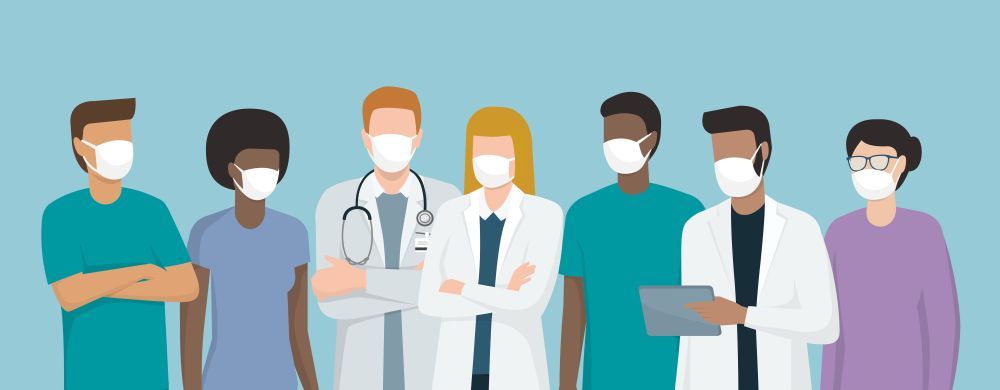Article
The Benefits of Wearing Personal Protective Equipment During the Pandemic
Author(s):
Mask-wearing can help protect individuals from COVID-19 infection—but it also has several other unexpected advantages.
elenabsl_AdobeStock

Throughout the COVID-19 pandemic, a lot of individuals who oppose the mask have cited several concerns including communication difficulties, discomfort, and subjective breathlessness. Cultural and social resistance to wearing masks appears to be related to a sense of loss of autonomy, and compliance appears to carry a subtext of weakness among certain social and political groups. There has been plenty of lay and scientific literature to specifically address these concerns, as well as the benefits of mask-wearing as it relates to SARS-CoV-2 transmission.
Aside from the reduction of transmission rates of COVID-19, mask-wearing has had other public health benefits, particularly as it relates to the transmission of other infectious upper-respiratory diseases. Indeed, a meta-analysis that looked at various infectious diseases and the pandemic found that “the risk of influenza, SARS, and COVID-19 infection was reduced by 45%, 74%, and 96% by wearing masks, respectively.”1 From a sociological perspective, masks also have an effect on individuals’ perceptions of one other.Tuberculosis is an example of a disease where such stigma is highly prevalent to the point that affected individuals are reluctant to wear masks in an attempt to avoid the stigma associated with the illness.2,3
Additionally, according to the Centers for Disease Control and Prevention (CDC), pediatric influenza rates have dropped during the pandemic partly due to mask-wearing, social distancing, and school closures. In terms of pediatric deaths, the CDC received 1 report of pediatric flu death in a child during the 2020 to 2021 flu season. Historically, flu death among children became nationally notifiable in 2004. Previously reported flu deaths among children ranged from a low of 37 (in 2011 and 2012) to a high of 199 (in 2019 and 2020).4
Another overlooked area where masks appear to be beneficial is physical fitness. It appears that even the downside of perceived breathlessness has the benefit of respiratory conditioning. A number of exercise benefits can be attributed to wearing an N95 mask by way of altered airway mechanics. N95 masks increase inspiratory resistance loads which lead to decreased intrathoracic, central venous, and intracranial pressures.5
Mask-wearing can also be positioned as a symbol of altruism and solidarity. According to Westhuizen et al, “given that the main purpose of face coverings by the public is source control, wearers could be depicted as altruistic or even as protectors. This could create new symbolism around wearing, making, and distributing face coverings that are based on social responsibility and solidarity against a common threat.”6
Lastly, the psychosocial impact of mask-wearing cannot be overlooked. Concerns have been raised regarding the impairment of speech development and hindrance in peer bonding and building social connections in young children. However, despite the lack of communication with visible facial expressions and body language, a considerable number of teenagers and young adults with social anxiety and body image issues have found solace in mask-wearing to boost their confidence and self-esteem.7 In fact, the recent lifting of the mask mandate has sparked a rise in feelings of anxiety and distress in some young adults, forcing them to continue to keep wearing their masks.
Mask wearing has proven to be an important preventative measure in the fight against not just SARS-CoV-2, but other communicable respiratory illnesses. It has also seemed to play a role in promoting a sense of social responsibility and solidarity as well as alleviating symptoms of social anxiety and body image issues in teenagers and young adults. Concerns regarding the possible demerits of mask-wearing include speech deficits and communication problems, breathing discomfort, and a loss of autonomy in making personal choices. The ancillary advantages however are all noteworthy and provide additional motivation for mask-wearing.
Dr. Kumari is a resident physician at Hackensack Meridian Health in Edison, New Jersey. Dr. Afzal is the residency program director at Hackensack Meridian Health. Dr. Doumas is chief of the Division of Child & Adolescent Psychiatry, director of the residency program, and vice chair of education and research at Hackensack Meridian Health. Dr. Alcera is the network medical director of Hackensack Meridian Health and chief medical officer of Preferred Behavioral Health Group in Lakewood, New Jersey. Dr. Solhkhah is chair of psychiatry and behavioral health at the Seton Hall University School of Medicine in South Orange, New Jersey.
The authors wish to thank Vinay Kumar, Amina Mahmood, and Sehar Raza for their assistance in searching for literature, proofreading, and editing this article.
References
1. Liang M, Gao L, Cheng C, et al. Efficacy of face mask in preventing respiratory virus transmission: a systematic review and meta-analysis. Travel Med Infect Dis. 2020;36:101751.
2. Abney K. “Containing” tuberculosis, perpetuating stigma: the materiality of N95 respirator masks. Anthropology Southern Africa. 2018;41(4):270-283.
3. Buregyeya E, Mitchell EMH, Rutebemberwa E, et al. Acceptability of masking and patient separation to control nosocomial tuberculosis in Uganda: a qualitative study. J Public Health. 2012;20(6):599-606.
4. 2020-2021 flu season summary. Centers for Disease Control and Prevention. Updated October 25, 2021. Accessed June 1, 2022. https://www.cdc.gov/flu/season/faq-flu-season-2020-2021.htm#:~:text=During%20the%202020%2D2021%20flu%20season%2C%20there%20was%20very%20low,%5B62.5%25%5D%20influenza%20B)
5. Davis BA, Tsen LC. Wearing an N95 respiratory mask: an unintended exercise benefit? Anesthesiology. 2020;133(3):684-686.
6. van der Westhuizen HM, Kotze K, Tonkin-Crine S, et al. Face coverings for covid-19: from medical intervention to social practice. BMJ. 2020;370:m3021.
7. Sohn E. For some teens, as masks come off, anxiety sets in. The New York Times. March 17, 2022. Accessed June 1, 2022. https://www.nytimes.com/2022/03/17/well/family/teenage-student-mask-anxiety.html





